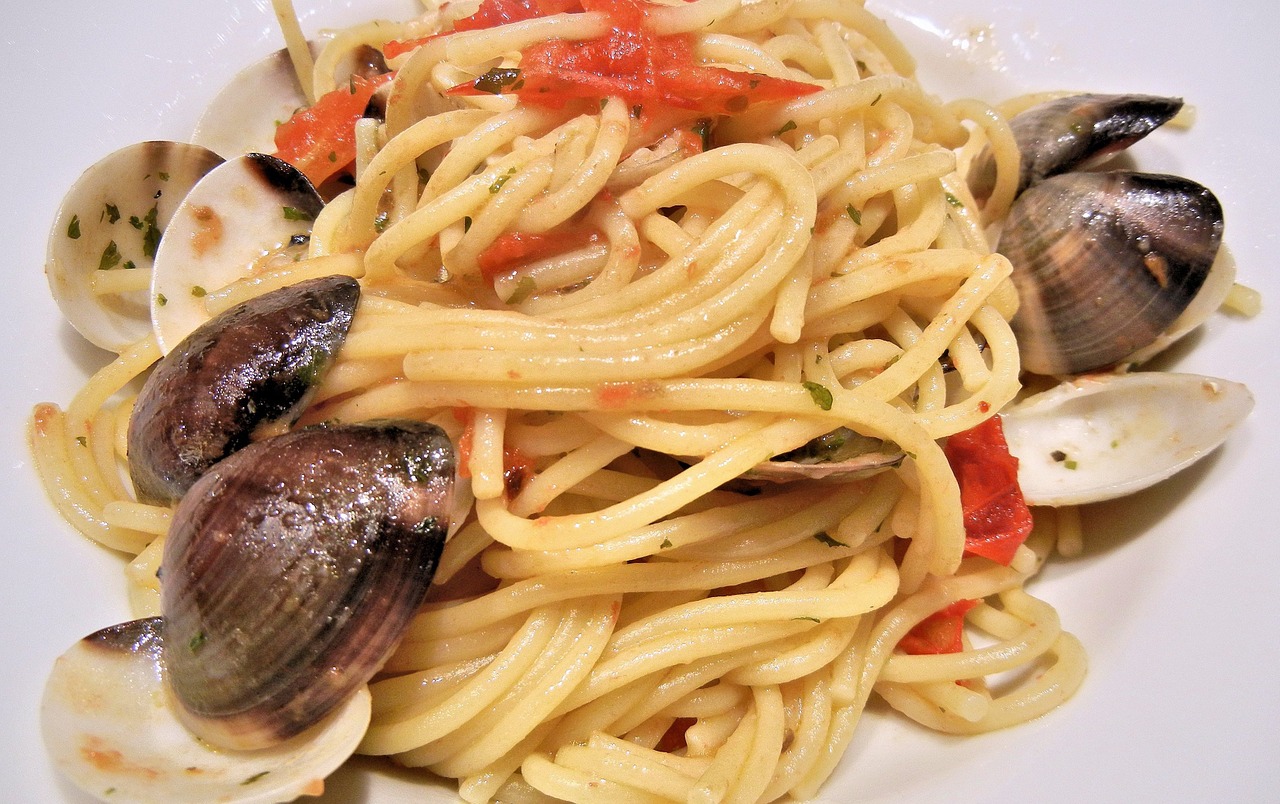For the difference between clams and mussels, my good old fashioned, real-life, literal books cookbooks proved more useful than the seemingly all-inclusive internet.
- Clam: any various bivalve mollusks, especially certain edible species
- Mussel: any bivalve mollusk, especially an edible bivalve of the family Mytilidae and a freshwater clam of the family Unioniade
- Oyster: any of several edible, marine, bivalve mollusks of the family Ostreidae, having an irregularly shaped shell, occurring on the bottom or adhering to rocks or other objects in shallow water
Right away, we can see that all three of these edible water-dwelling creatures are “bilvalve mollusks.” Bilvalve mollusks have an outside covering with a two-part hinged shell containing a somewhat gelatinous food delight inside.
As Mark Bittman says, “Mollusks, they’re called, and they’re among the tastiest sea creatures that exist.”
Despite this commonality, clams, mussels, and oysters are all considered to be distinctly different species.
Let us take a look at each shellfish by itself.
Clams:
- Can live in salt or fresh water.
- Typically have smooth, shiny, hard shells.
- Can be steamed or eaten raw.
- Cannot be eaten raw if they are soft-shelled.
- Have a “foot” they use to travel.
Mussels:
- Can live in salt or fresh water.
- Are fairly mobile.
- Have a rough shell.
- Can only be consumed cooked.
- Require a “beard” to be scraped off when preparing.
Oysters:
- Only live in salt water.
- Have a somewhat smooth shell.
- Can be eaten raw or cooked.
- Attach themselves to one spot for most of their lives.
True notions of all three:
- They must be alive when bought in the shell.
- When dead, the shellfish smell badly, so it would be unlikely to accidentally purchase them unfresh.
- If shells are open a little, they should close quickly when tapped lightly.
- Although they’re quite different in appearance and taste, all three can be prepared the same way: by cooking them until the shells open, or shucking them and cooking as you would other fish.
For the cookbooks I looked into for this Difference Between, I took advantage of Mark Bittman’s How to Cook Everything, and Barton Seaver’s For Cod and Country.
Although the latter clearly concentrates solely on seafood, I found How to Cook Everything provided a bit more specific data I was looking for – shown in many of the bullet points above.
According to Bittman, fresh clams only need lemon to be paired with – nothing else. “Sauces are superfluous.” Given that information, I assume that clams are a food to be enjoyed on its own, soaking in its own essence, unobstructed from distracting flavors.
By contrast, mussels, as reported by Seaver, can be prepared in many different ways: smoked, marinated, or steamed. Furthermore, any basic pairings you can think of – wine and herbs, tomato sauce and “whatever else” – will probably go with mussels perfectly.
A significant aspect of all three clams, mussels, and oysters that was not mentioned previously is that they’re good for the environment. Indeed, the mollusks all filter excess nutrients out of the water they reside in, subsequently improving the water quality.
Clams and mussels are healthy for us as well, with a high iron and vitamin B-12 content. Oysters are rich in protein, but do contain cholesterol.
By the way, scallops are also bivalve mussels. They are more mobile than their other shellfish siblings when living, and just as tasty when on our plates.

Comments
9 responses to “Difference between: clams and mussels (and oysters)”
Greetings!
Very good information. We went to fresh fish market in Dearborn, Detroit,Mi.
We were confused and could take only oysters and clams. Messels we could not figure out althoug black shelves were shown to us.
Now it is very much clear.
Thank you for information
Thanks for the information found it quite useful
Very good. Useful, informative, educational and entertaining subject. not to mention tasty too..good job:)
Very helpful! Where did you get all that info? Where can I learn more?
I am allergic or have a food sensitivity to mussels and scallops. The slightest amount makes me sick for many hours. I can eat Clams and oysters with no problems. Do you know of any commonalities between mussels and scallops that are not present in Clams and oysters?
Not that I’m aware of or that I could find. It appears mollusk allergies are not terribly common, but if you have one, you’re advised to avoid all of them. That being said, it’s not terribly surprising to me you’re allergic/sensitive to one and not another, because they are in fact different species.
Food allergies (and I imagine sensitivities as well), vary so widely from person to person it can be hard to pinpoint things like this. To add to the confusion allergies can appear later in life, or fade away as time goes on.
I will keep digging into this and see if I can find a seafood expert who can weigh in.
I found the information was very informative. It help me understand how alike and how different clams, muscles and oysters are.
Good stuff, thank you for sharing.
Nice you notes